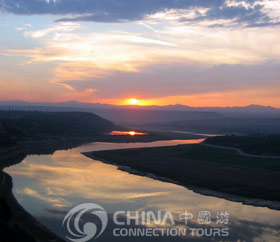
 The Huang He or Yellow River rises in northern China in a series of springs and lakes in the mountains of Qinghai Province, south of the Gobi Desert. From its source, the river flows east through deep gorges before turning northeast at the city of Lanzhou in Gansu Province. At that point it flows for many hundreds of kilometers through the Ordos Desert (Mu Us Shamo), an easterly extension of the Gobi. The river then flows due east for about 320 km (about 200 miles). It then turns due south, cutting into deposits of loamy soil known as loess between Shaanxi and Shanxi Provinces. In this portion of its course, the river picks up and carries in suspension yellow silt, which colors the water and gives the river its name. The Wei River enters the Huang He in the central portion of Shaanxi, and the combined rivers then flows east across the northern portion of Henan Province to the plains of northern China.
The Huang He or Yellow River rises in northern China in a series of springs and lakes in the mountains of Qinghai Province, south of the Gobi Desert. From its source, the river flows east through deep gorges before turning northeast at the city of Lanzhou in Gansu Province. At that point it flows for many hundreds of kilometers through the Ordos Desert (Mu Us Shamo), an easterly extension of the Gobi. The river then flows due east for about 320 km (about 200 miles). It then turns due south, cutting into deposits of loamy soil known as loess between Shaanxi and Shanxi Provinces. In this portion of its course, the river picks up and carries in suspension yellow silt, which colors the water and gives the river its name. The Wei River enters the Huang He in the central portion of Shaanxi, and the combined rivers then flows east across the northern portion of Henan Province to the plains of northern China.
At the city of Kaifeng, the river enters the plains and changes from a torrent to a meandering stream with a broad channel enclosed by dikes. The dikes were built over a period of centuries to control the river and prevent floods, but they have actually had the opposite effect. Because the large amount of sediment carried by the stream has been deposited on the bottom of the riverbed, the level of the river has risen, necessitating the construction of higher and higher dikes. If the dikes had not been built, the silt would have been deposited on the floodplain along the riverbed. Because of this silting action, in some places, along the lower course of the river, it is as much as 21 m (70 ft) above the surrounding plain, and when the river level rises, disastrous floods occur.
The deforestation of the mountains in the upper course of the river has increased the runoff and thus increased the flood heights. The floods of the Huang He have been so frequent and so devastating that the river is often called "China's Sorrow." The worst flood in the history of the river, and probably the worst flood in modern times, occurred in 1931. Between July and November, some 88,000 sq km (some 34,000 sq mi) of land were completely flooded, and about 21,000 sq km (about 8000 sq mi) more were partially flooded. Approximately 80 million people were left homeless and about 1 million died in the flood itself and in the famines and epidemics that followed.
The Huang He has changed course in the eastern portion of the country a number of times. For several centuries before 1852, it emptied into the Yellow Sea, south of the highlands of Shandong Province. The course shifted north that year, and, from that time until 1938, the river emptied into the gulf of Bo Hai. In 1938, during the Second Sino-Japanese War, Chinese forces, seeking to impede the invading Japanese, destroyed the dikes near Kaifeng and diverted the Huang He to the old bed. The dikes were rebuilt in 1946-1947, redirecting the river to the Bo Hai.
Construction of a dam across the Huang He at Three-Gate Gorge was begun in 1956, with funding from the Union of Soviet Socialist Republics (USSR). When relations between the USSR and China chilled in 1960, the USSR withdrew financial aid, which delayed the project's completion until the mid-1970s. The dam created a reservoir about 190 km (about 120 mi) long, opening more of the river to navigation. However, by the time a generating plant with a capacity of 1 million kilowatts was finished in the early 1970s, the reservoir had already begun to fill with silt, making power generation only a quarter of that expected. It is anticipated the reservoir will fill entirely with silt by the middle of the 21st century.

